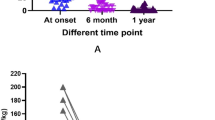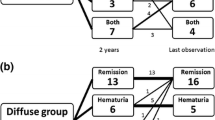Abstract
Background
The long-term renal outcome for IgA nephropathy (IgAN) in large cohorts of children remains unclear. IgAN is a progressive disease, to explore novel biomarkers is necessary for predicting the disease activity and progression of IgAN. In addition, there is a hot debate on when to treat with immunosuppression in children. We aimed to confirm the long-term renal survival, find some undetected risk factors and investigate when to treat with immunosuppression can benefit for renal outcome in Chinese children.
Methods
1243 Children with IgAN were enrolled and a follow-up of at least 1 year after a biopsy from 2000 to 2017. Long-term renal survival, undetected risk factors and the renal survival of immunosuppressive and non-immunosuppressive therapy were evaluated. The primary endpoint of the study was a combined outcome of either ≥50% reduction in estimated glomerular filtration rate (eGFR) or end-stage renal disease (ESRD) or death.
Results
The median follow-up time were 86.8 months (interquartile range 54.7–140.2 months). The 5-, 10- and 15-year renal survival rates were 95.3%, 90.3% and 84%, respectively. Cox multivariate regression and Kaplan–Meier analysis showed that hypertension, hyperuricemia, high 24 h urine protein (24 h-UP) levels, lower initial eGFR, high urine C3 levels, high retinol-binding protein (RBP) levels, segmental glomerulosclerosis (S) and tubular atrophy and interstitial fibrosis (T) were associated with renal outcome. The statistically significant predictive perfect power for renal outcome was RBP ≥ 0.7µg/ml (AUC = 0.899, sensitivity = 84.00%, specificity = 86.00%), 24 h-UP ≥ 1 g/24 h (AUC = 0.722, sensitivity = 84.20%, specificity = 52.70%), eGFR < 60 ml/min/1.73 m2 (AUC = 0.718, sensitivity = 81.30%, specificity = 39.20%) and S1 lesion (AUC = 0.703, sensitivity = 75.50%, specificity = 65.10%).Children with urinary RBP ≥ 0.7µg/ml were associated with a 2.513-fold risk than patients with urinary RBP < 0.7µg/ml (P = 0.003). Our study suggested that immunosuppressive therapy may reduce the risk of progression in IgAN children had both eGFR > 50 ml/min/1.73 m2 and proteinuria of at least 1 g/day.
Conclusions
This is the first report that the 15-year renal survival rate of children with IgAN in China was 84%. At the same time, this is the first study to reveal that urinary RBP ≥ 0.7µg/ml may indicate a poor renal outcome. In addition, this study supports immunosuppressive therapy for IgAN children had both proteinuria ≥1 g/day and initial eGFR > 50 ml/min/1.73m2.




Similar content being viewed by others
References
Lechner SM, Papista C, Chemouny JM, Berthelot L, Monteiro RC (2016) Role of IgA receptors in the pathogenesis of IgA nephropathy. J Nephrol 29(1):5–11. https://doi.org/10.1007/s40620-015-0246-5
Wyatt RJ, Hogg RJ (2001) Evidence-based assessment of treatment options for children with IgA nephropathies. Pediatr Nephrol 16(2):156–167. https://doi.org/10.1007/s004670000517
Radhakrishnan J, Cattran DC (2012) The KDIGO practice guideline on glomerulonephritis: reading between the (guide)lines—application to the individual patient. Kidney Int 82(8):840–856. https://doi.org/10.1038/ki.2012.280
Tesar V, Troyanov S, Bellur S, Verhave JC, Cook HT, Feehally J, Roberts IS, Cattran D, Coppo R (2015) Corticosteroids in IgA nephropathy: a retrospective analysis from the VALIGA study. J Am Soc Nephrol 26(9):2248–2258. https://doi.org/10.1681/ASN.2014070697
Mian AN, Schwartz GJ (2017) Measurement and estimation of glomerular filtration rate in children. Adv Chronic Kidney Dis 24(6):348–356. https://doi.org/10.1053/j.ackd.2017.09.011
Chi XH, Li GP, Wang QS, Qi YS, Huang K, Zhang Q, Xue YM (2017) CKD-EPI creatinine-cystatin C glomerular filtration rate estimation equation seems more suitable for Chinese patients with chronic kidney disease than other equations. BMC Nephrol 18(1):226. https://doi.org/10.1186/s12882-017-0637-z
Trimarchi H, Barratt J, Cattran DC, Cook HT, Coppo R, Haas M, Liu ZH, Roberts IS, Yuzawa Y, Zhang H, Feehally J (2017) Oxford Classification of IgA nephropathy 2016: an update from the IgA nephropathy classification working group. Kidney Int 91(5):1014–1021. https://doi.org/10.1016/j.kint.2017.02.003
Coppo R, Lofaro D, Camilla RR, Bellur S et al (2017) Risk factors for progression in children and young adults with IgA nephropathy: an analysis of 261 cases from the VALIGA European cohort. Pediatr Nephrol 32(1):139–150. https://doi.org/10.1007/s00467-016-3469-3
Soares MF (2016) An update on pathology of IgA nephropathy. J Bras Nefrol 38(4):435–440. https://doi.org/10.5935/0101-2800.20160069
Yata N, Nakanishi K, Shima Y, Togawa H, Obana M, Sako M, Nozu K, Tanaka R, Iijima K, Yoshikawa N (2008) Improved renal survival in Japanese children with IgA nephropathy. Pediatr Nephrol 23(6):905–912. https://doi.org/10.1007/s00467-007-0726-5
Fabiano R, Araujo SA, Bambirra EA, Oliveira EA, Simoes ESA, Pinheiro S (2017) The Oxford classification predictors of chronic kidney disease in pediatric patients with IgA nephropathy. J Pediatr (Rio J) 93(4):389–397. https://doi.org/10.1016/j.jped.2016.09.003
Pozzi C (2016) Treatment of IgA nephropathy. J Nephrol 29(1):21–25. https://doi.org/10.1007/s40620-015-0248-3
Moriyama T, Itabashi M, Takei T, Kataoka H, Sato M, Shimizu A, Iwabuchi Y, Nishida M, Uchida K, Nitta K (2015) High uric acid level is a risk factor for progression of IgA nephropathy with chronic kidney disease stage G3a. J Nephrol 28(4):451–456. https://doi.org/10.1007/s40620-014-0154-0
Shu D, Xu F, Su Z, Zhang J, Chen C, Zhang J, Ding X, Lv Y, Lin H, Huang P (2017) Risk factors of progressive IgA nephropathy which progress to end stage renal disease within ten years: a case–control study. BMC Nephrol 18(1):11. https://doi.org/10.1186/s12882-016-0429-x
Le W, Liang S, Hu Y, Deng K, Bao H, Zeng C, Liu Z (2012) Long-term renal survival and related risk factors in patients with IgA nephropathy: results from a cohort of 1155 cases in a Chinese adult population. Nephrol Dial Transplant 27(4):1479–1485. https://doi.org/10.1093/ndt/gfr527
Maixnerova D, Reily C, Bian Q, Neprasova M, Novak J, Tesar V (2016) Markers for the progression of IgA nephropathy. J Nephrol 29(4):535–541. https://doi.org/10.1007/s40620-016-0299-0
Sobotka R, Capoun O, Kalousova M, Hanus T, Zima T, Kostirova M, Soukup V (2017) Prognostic importance of vitamins A, E and retinol-binding protein 4 in renal cell carcinoma patients. Anticancer Res 37(7):3801–3806. https://doi.org/10.21873/anticanres.11757
An C, Akankwasa G, Liu J, Wang D, Cheng G, Zhang J, Qin X (2019) Urine markers of renal tubular injury in idiopathic membranous nephropathy: a cross sectional study. Clin Chim Acta 492:7–11. https://doi.org/10.1016/j.cca.2019.01.015
Okada K, Funai M, Kawakami K, Kagami S, Yano I, Kuroda Y (1990) IgA nephropathy in Japanese children and adults: a comparative study of clinicopathological features. Am J Nephrol 10(3):191–197. https://doi.org/10.1159/000168080
Mina SN, Murphy WM (1985) IgA nephropathy a comparative study of the clinicopathologic features in children and adults. Am J Clin Pathol 83(6):669–675. https://doi.org/10.1093/ajcp/83.6.669
Ikezumi Y, Suzuki T, Imai N, Ueno M, Narita I, Kawachi H, Shimizu F, Nikolic-Paterson DJ, Uchiyama M (2006) Histological differences in new-onset IgA nephropathy between children and adults. Nephrol Dial Transplant 21(12):3466–3474. https://doi.org/10.1093/ndt/gfl455
Grcevska L, Ristovska V, Nikolov V, Petrusevska G, Milovanceva-Popovska M, Polenakovic M (2010) The Oxford classification of IgA nephropathy: single centre experience. Prilozi 31(2):7–16
Katafuchi R, Ninomiya T, Nagata M, Mitsuiki K, Hirakata H (2011) Validation study of oxford classification of IgA nephropathy: the significance of extracapillary proliferation. Clin J Am Soc Nephrol 6(12):2806–2813. https://doi.org/10.2215/CJN.02890311
Herzenberg AM, Fogo AB, Reich HN, Troyanov S, Bavbek N, Massat AE, Hunley TE, Hladunewich MA, Julian BA, Fervenza FC, Cattran DC (2011) Validation of the Oxford classification of IgA nephropathy. Kidney Int 80(3):310–317. https://doi.org/10.1038/ki.2011.126
Shi SF, Wang SX, Jiang L, Lv JC, Liu LJ, Chen YQ, Zhu SN, Liu G, Zou WZ, Zhang H, Wang HY (2011) Pathologic predictors of renal outcome and therapeutic efficacy in IgA nephropathy: validation of the oxford classification. Clin J Am Soc Nephrol 6(9):2175–2184. https://doi.org/10.2215/CJN.11521210
Yau T, Korbet SM, Schwartz MM, Cimbaluk DJ (2011) The Oxford classification of IgA nephropathy: a retrospective analysis. AM J NEPHROL 34(5):435–444. https://doi.org/10.1159/000332223
Kang SH, Choi SR, Park HS, Lee JY, Sun IO, Hwang HS, Chung BH, Park CW, Yang CW, Kim YS, Choi YJ, Choi BS (2012) The Oxford classification as a predictor of prognosis in patients with IgA nephropathy. Nephrol Dial Transplant 27(1):252–258. https://doi.org/10.1093/ndt/gfr295
Le W, Zeng CH, Liu Z, Liu D, Yang Q, Lin RX, Xia ZK, Fan ZM, Zhu G, Wu Y, Xu H, Zhai Y, Ding Y, Yang X, Liang S, Chen H, Xu F, Huang Q, Shen H, Wang J, Fogo AB, Liu ZH (2012) Validation of the Oxford classification of IgA nephropathy for pediatric patients from China. BMC Nephrol 13:158. https://doi.org/10.1186/1471-2369-13-158
Lee H, Yi SH, Seo MS, Hyun JN, Jeon JS, Noh H, Han DC, Hwang SD, Jin SY, Kwon SH (2012) Validation of the Oxford classification of IgA nephropathy: a single-center study in Korean adults. Korean J Intern Med 27(3):293–300. https://doi.org/10.3904/kjim.2012.27.3.293
Moriyama T, Nakayama K, Iwasaki C, Ochi A, Tsuruta Y, Itabashi M, Tsukada M, Takei T, Uchida K, Nitta K (2012) Severity of nephrotic IgA nephropathy according to the Oxford classification. Int Urol Nephrol 44(4):1177–1184. https://doi.org/10.1007/s11255-011-0109-5
Shima Y, Nakanishi K, Hama T, Mukaiyama H, Togawa H, Hashimura Y, Kaito H, Sako M, Iijima K, Yoshikawa N (2012) Validity of the Oxford classification of IgA nephropathy in children. Pediatr Nephrol 27(5):783–792. https://doi.org/10.1007/s00467-011-2061-0
Tanaka S, Ninomiya T, Katafuchi R, Masutani K, Tsuchimoto A, Noguchi H, Hirakata H, Tsuruya K, Kitazono T (2013) Development and validation of a prediction rule using the Oxford classification in IgA nephropathy. Clin J Am Soc Nephrol 8(12):2082–2090. https://doi.org/10.2215/CJN.03480413
Zeng CH, Le W, Ni Z, Zhang M, Miao L, Luo P, Wang R, Lv Z, Chen J, Tian J, Chen N, Pan X, Fu P, Hu Z, Wang L, Fan Q, Zheng H, Zhang D, Wang Y, Huo Y, Lin H, Chen S, Sun S, Wang Y, Liu Z, Liu D, Ma L, Pan T, Zhang A, Jiang X, Xing C, Sun B, Zhou Q, Tang W, Liu F, Liu Y, Liang S, Xu F, Huang Q, Shen H, Wang J, Shyr Y, Phillips S, Troyanov S, Fogo A, Liu ZH (2012) A multicenter application and evaluation of the oxford classification of IgA nephropathy in adult Chinese patients. Am J Kidney Dis 60(5):812–820. https://doi.org/10.1053/j.ajkd.2012.06.01
Coppo R, Troyanov S, Bellur S, Cattran D, Cook HT, Feehally J, Roberts IS, Morando L, Camilla R, Tesar V, Lunberg S, Gesualdo L, Emma F, Rollino C, Amore A, Praga M, Feriozzi S, Segoloni G, Pani A, Cancarini G, Durlik M, Moggia E, Mazzucco G, Giannakakis C, Honsova E, Sundelin BB, Di Palma AM, Ferrario F, Gutierrez E, Asunis AM, Barratt J, Tardanico R, Perkowska-Ptasinska A (2014) Validation of the Oxford classification of IgA nephropathy in cohorts with different presentations and treatments. Kidney Int 86(4):828–836. https://doi.org/10.1038/ki.2014.63
Hisano S, Joh K, Katafuchi R, Shimizu A, Hashiguchi N, Kawamura T, Matsuo S (2017) Reproducibility for pathological prognostic parameters of the Oxford classification of IgA nephropathy: a Japanese cohort study of the Ministry of Health Labor and Welfare. Clin Exp Nephrol 21(1):92–96. https://doi.org/10.1007/s10157-016-1258-8
Alamartine E, Sauron C, Laurent B, Sury A, Seffert A, Mariat C (2011) The use of the Oxford classification of IgA nephropathy to predict renal survival. Clin J Am Soc Nephrol 6(10):2384–2388. https://doi.org/10.2215/CJN.01170211
Stangou M, Ekonomidou D, Giamalis P, Liakou H, Tsiantoulas A, Pantzaki A, Papagianni A, Efstratiadis G, Alexopoulos E, Memmos D (2011) Steroids and azathioprine in the treatment of IgA nephropathy. Clin Exp Nephrol 15(3):373–380. https://doi.org/10.1007/s10157-011-0415-3
Pozzi C, Andrulli S, Pani A, Scaini P, Roccatello D, Fogazzi G, Pecchini P, Rustichelli R, Finocchiaro P, Del VL, Locatelli F (2013) IgA nephropathy with severe chronic renal failure: a randomized controlled trial of corticosteroids and azathioprine. J Nephrol 26(1):86–93. https://doi.org/10.5301/jn.5000110
Acknowledgements
The authors acknowledge support from the Clinical Advanced Techniques, Primary Research and Development Plan of Jiangsu Province (BE2017719) and the Paediatric Medical Innovation Team of Jiangsu Province (CXTDA2017022).
Author information
Authors and Affiliations
Corresponding authors
Ethics declarations
Conflict of interest
None.
Additional information
Publisher's Note
Springer Nature remains neutral with regard to jurisdictional claims in published maps and institutional affiliations.
Electronic supplementary material
Below is the link to the electronic supplementary material.
Rights and permissions
About this article
Cite this article
Wu, H., Fang, X., Xia, Z. et al. Long-term renal survival and undetected risk factors of IgA nephropathy in Chinese children—a retrospective 1243 cases analysis from single centre experience. J Nephrol 33, 1263–1273 (2020). https://doi.org/10.1007/s40620-020-00767-4
Received:
Accepted:
Published:
Issue Date:
DOI: https://doi.org/10.1007/s40620-020-00767-4




